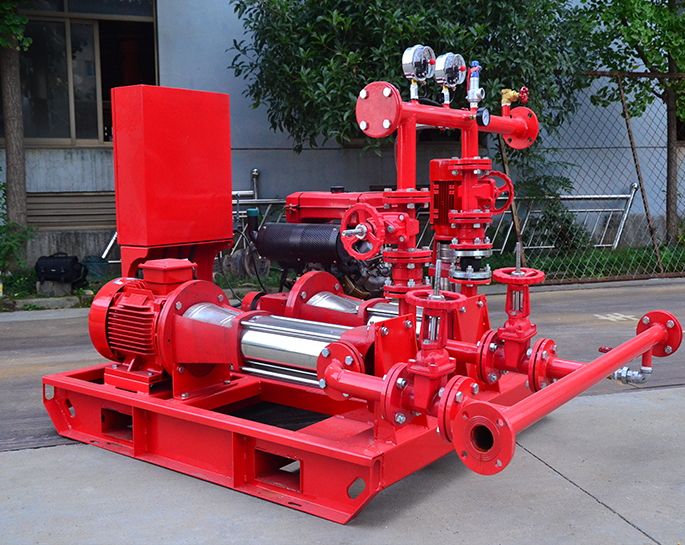How do firefighting pumps contribute to disaster resilience and community preparedness initiatives?
Feb 23, 2024
Share:
Firefighting pumps play a critical role in disaster resilience and community preparedness initiatives in several ways:
1. **Immediate Response Capability:** Firefighting pumps provide communities with immediate response capability in the event of fires, natural disasters such as wildfires, floods, or earthquakes, and other emergencies. Having reliable pumps ensures that firefighting efforts can begin promptly, helping to minimize property damage and save lives.
2. **Water Supply Augmentation:** In situations where municipal water supplies may be compromised or unavailable, firefighting pumps can augment water sources from nearby lakes, rivers, ponds, or other bodies of water. This ability to access alternative water sources increases resilience and ensures that firefighters have the necessary resources to combat emergencies effectively.
3. **Wildfire Prevention and Management:** Firefighting pumps are essential tools for wildfire prevention and management efforts. They enable firefighters to establish firebreaks, conduct controlled burns, and deploy water or fire retardants to contain and suppress wildfires before they spread further.
4. **Supporting Emergency Response Infrastructure:** Firefighting pumps are integral components of emergency response infrastructure, supporting fire departments, emergency management agencies, and other organizations responsible for disaster preparedness and response. Investing in robust firefighting pump systems enhances the overall resilience of communities by bolstering their ability to handle various emergencies.
5. **Community Engagement and Training:** Incorporating firefighting pumps into community preparedness initiatives can help raise awareness about fire safety and emergency response procedures. Community members can be trained in the proper use and maintenance of pumps, increasing their capacity to respond effectively to emergencies and bolstering overall community resilience.
6. **Mitigating Property Damage:** Timely deployment of firefighting pumps can help mitigate property damage caused by fires, floods, or other disasters. By quickly establishing water supplies and implementing firefighting strategies, pumps enable responders to contain and extinguish fires or manage flooding, reducing the extent of damage to homes, businesses, and infrastructure.
7. **Enhancing Resilience in Remote Areas:** In remote or rural areas with limited access to municipal firefighting services, firefighting pumps are essential for building resilience against wildfires, forest fires, and other emergencies. These pumps enable communities to mount effective firefighting efforts even in areas where traditional firefighting infrastructure may be lacking.
Overall, firefighting pumps are indispensable assets for enhancing disaster resilience and community preparedness initiatives by providing reliable water supply, supporting emergency response efforts, and empowering communities to respond effectively to a wide range of emergencies and disasters.

1. **Immediate Response Capability:** Firefighting pumps provide communities with immediate response capability in the event of fires, natural disasters such as wildfires, floods, or earthquakes, and other emergencies. Having reliable pumps ensures that firefighting efforts can begin promptly, helping to minimize property damage and save lives.
2. **Water Supply Augmentation:** In situations where municipal water supplies may be compromised or unavailable, firefighting pumps can augment water sources from nearby lakes, rivers, ponds, or other bodies of water. This ability to access alternative water sources increases resilience and ensures that firefighters have the necessary resources to combat emergencies effectively.
3. **Wildfire Prevention and Management:** Firefighting pumps are essential tools for wildfire prevention and management efforts. They enable firefighters to establish firebreaks, conduct controlled burns, and deploy water or fire retardants to contain and suppress wildfires before they spread further.
4. **Supporting Emergency Response Infrastructure:** Firefighting pumps are integral components of emergency response infrastructure, supporting fire departments, emergency management agencies, and other organizations responsible for disaster preparedness and response. Investing in robust firefighting pump systems enhances the overall resilience of communities by bolstering their ability to handle various emergencies.
5. **Community Engagement and Training:** Incorporating firefighting pumps into community preparedness initiatives can help raise awareness about fire safety and emergency response procedures. Community members can be trained in the proper use and maintenance of pumps, increasing their capacity to respond effectively to emergencies and bolstering overall community resilience.
6. **Mitigating Property Damage:** Timely deployment of firefighting pumps can help mitigate property damage caused by fires, floods, or other disasters. By quickly establishing water supplies and implementing firefighting strategies, pumps enable responders to contain and extinguish fires or manage flooding, reducing the extent of damage to homes, businesses, and infrastructure.
7. **Enhancing Resilience in Remote Areas:** In remote or rural areas with limited access to municipal firefighting services, firefighting pumps are essential for building resilience against wildfires, forest fires, and other emergencies. These pumps enable communities to mount effective firefighting efforts even in areas where traditional firefighting infrastructure may be lacking.
Overall, firefighting pumps are indispensable assets for enhancing disaster resilience and community preparedness initiatives by providing reliable water supply, supporting emergency response efforts, and empowering communities to respond effectively to a wide range of emergencies and disasters.







